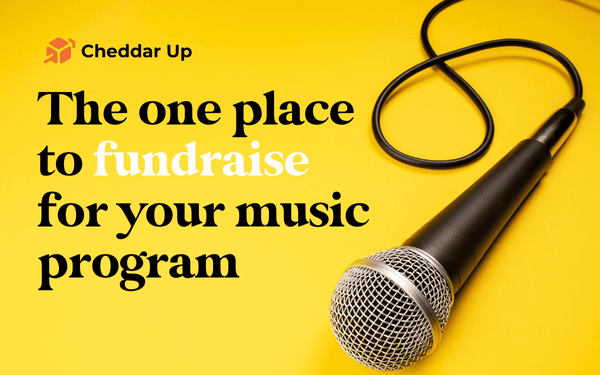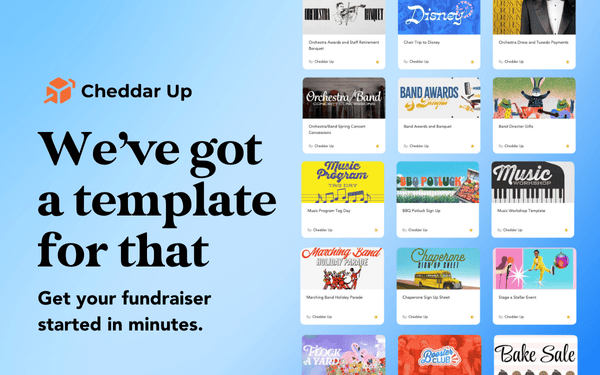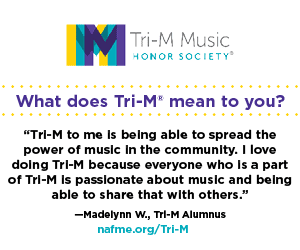/ News Posts / A Music Educator’s Guide to Fundraising Success
A Music Educator’s Guide to Fundraising Success
Strategies and Tips to Hit the Right Notes
This blog is sponsored by NAfME Corporate member Cheddar Up.
Fundraising is often the heartbeat of a thriving music program. Whether it’s for new instruments, competition fees, uniforms, or trip expenses, raising funds ensures your students have the resources they need to succeed. But let’s face it—fundraising can feel overwhelming, especially when you’re already juggling rehearsals, lesson plans, and performances.
The good news? With a little creativity, some strategic planning, and the right tools (like Cheddar Up), fundraising doesn’t have to be a stressful experience. Here’s a detailed guide to help music educators simplify and supercharge their fundraising efforts.
1. Set Clear Goals and Share Your “Why”
Every successful fundraiser starts with a clear purpose. Before you even choose a fundraising method, take time to define your goals and communicate them to your audience.
- Identify what you’re raising funds for: Be specific. Are you trying to purchase new instruments? Cover travel costs for a competition? Fund scholarships for students in need? When people know exactly what their contributions will support, they’re more likely to give.
- Set a realistic goal: Figure out how much you need to raise and break it down into manageable targets. For example, if you’re fundraising for a $5,000 competition trip, let donors know how many students their contributions will help sponsor.
- Tell your story: Connect your fundraiser to your students’ growth and achievements. Share stories about how your music program has made a difference in their lives or how these funds will create new opportunities. People don’t just donate to causes—they donate to stories that inspire them.
2. Choose Fundraising Methods That Work for You
There are countless ways to raise funds, but the best approach is one that suits your community and makes it easy for people to give. Here are some tried-and-true options with templates you can use to get started right away:
- Concert Fundraisers: Combine your students’ talents with your fundraising goals by hosting a special performance. Sell tickets online and set up a donation station at the event. Consider offering VIP tickets with perks like reserved seating to encourage larger donations. Get the concert ticket template.
- Online Donation Campaigns: Create a donation page where supporters can contribute directly to your program. Use visuals like photos or videos of your students in action to show the impact of their donations. Add a progress tracker so people can see how close you are to reaching your goal. Get the donation template.
- Product Sales: From spirit wear to cookie dough, selling items is a popular way to fundraise. Consider offering products tied to your program, like branded T-shirts, reusable water bottles, or tote bags featuring your school or music logo. Get the spirit wear template.
- Raffles and Auctions: Host a raffle or auction at your next event. Reach out to local businesses for donated items or services (think gift cards, concert tickets, or music lessons) to keep costs low and excitement high.
- Crowdfunding Challenges: Gamify your fundraiser by setting challenges for donors, such as “Sponsor a Song” (donate a certain amount to have the students perform a specific piece) or milestone celebrations when you hit certain funding levels. Get the sponsor challenge template.
Pro Tip: Diversify your methods to reach different segments of your community. For example, parents might support a ticketed event, while alumni and local businesses might prefer an online donation page or sponsorship opportunity. Check out this music fundraising resource center for even more ideas.
3. Simplify Payments and Keep Everything Organized
One of the biggest headaches of fundraising is managing payments and tracking contributions. Going digital not only simplifies the process for you, but also makes it easier for supporters to give.
- Collect Payments Online: Set up an online platform where people can donate, purchase tickets, or pay for fundraiser items.
- Offer Flexible Payment Options: Allow donors to pay via credit card, ACH, or cash/check. The easier it is to give, the more likely they are to contribute.
- Track Donations in Real Time: Use a system that automatically tracks payments, donor names, and totals. This keeps you organized and saves you from hours of manual data entry.
Transparency is key—being able to quickly show how much you’ve raised and where the funds are going builds trust with your supporters.
4. Engage Your Community and Build Momentum
Fundraisers are more successful when they feel like a shared effort. By actively engaging your community, you create excitement and encourage participation.
- Promote Your Fundraiser: Use every channel available—social media, school newsletters, emails, and posters—to spread the word. Share updates regularly, like how close you are to reaching your goal or shoutouts to top donors.
- Involve Your Students: Encourage your students to be part of the fundraiser by helping with promotion or sharing why the fundraiser is important to them. A heartfelt message from a student can be incredibly persuasive.
- Host a Kickoff Event: Start your fundraiser with a bang by hosting an event, such as a mini-performance, to generate buzz and set the tone. Use the opportunity to explain your goals and encourage attendees to donate or participate.
- Celebrate Milestones: Every time you reach a percentage of your goal, celebrate it with your community. Post updates, share photos of students benefiting from the fundraiser, or even host mini-rewards like a livestreamed performance.
5. Maximize In-Person Fundraisers
If you’re hosting a concert or event as part of your fundraiser, make it easy for attendees to give on the spot.
- Set Up Donation Stations: Use QR codes or tablets at your event that link directly to your online donation page. Attendees can make contributions without needing to carry cash.
- Offer Multiple Ways to show support: Let people choose how they support your program. For example, attendees might donate during checkout when purchasing tickets, purchase concessions or merchandise at the event, or participate in an online auction or raffle.
- Capture Contact Information: At in-person events, collect emails from attendees so you can thank them afterward and keep them informed about future opportunities to support your program.
6. Follow Up and Say Thank You
After your fundraiser wraps up, don’t skip the most important step: showing gratitude to everyone who supported your cause.
- Send personalized thank-yous: Take the time to thank your donors with a heartfelt message. If possible, personalize your notes by mentioning their specific contribution or how it will help. PRO TIP: Have students help with thank-you notes to give it a personal touch and save you time!
- Report back: Let your supporters know how much you raised and how the funds will be used. Include photos or videos of your students benefiting from the donations—it’s a powerful way to show the direct impact of their support.
- Keep the relationship going: Fundraising isn’t just about raising money—it’s about building lasting connections. Stay in touch with your donors through email updates or invitations to future events to keep them engaged with your program.
The Right Tools Make All the Difference
Fundraising for a music program involves a lot of moving parts, but the process doesn’t have to be overwhelming. With a platform like Cheddar Up, you can simplify every aspect of your fundraiser. From creating custom donation pages and selling tickets to tracking payments and automating thank-you messages, Cheddar Up helps you stay organized and focused on your goal.
Whether you’re hosting a concert, selling spirit wear, or running an online donation campaign, remember that the most successful fundraisers are the ones that make it easy for people to give, share a compelling story, and bring the community together. With a little planning and creativity, you can hit all the right notes and fundraise like a pro!
Start your next fundraiser today!
Interested in reprinting this article? Please review the reprint guidelines.
The National Association for Music Education (NAfME) provides a number of forums for the sharing of information and opinion, including blogs and postings on our website, articles and columns in our magazines and journals, and postings to our Amplify member portal. Unless specifically noted, the views expressed in these media do not necessarily represent the policy or views of the Association, its officers, or its employees.
Published Date
February 6, 2025
Category
- Budgeting
- Funding
- Program Development
Copyright
February 6, 2025. © National Association for Music Education (NAfME.org)






